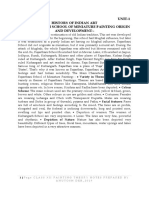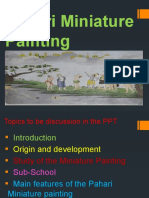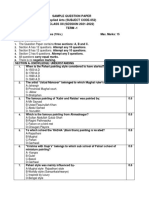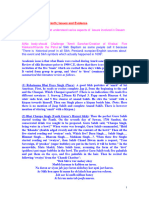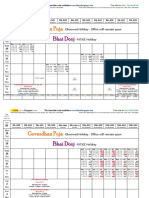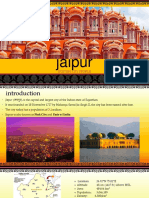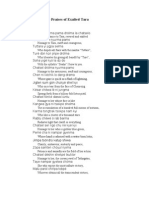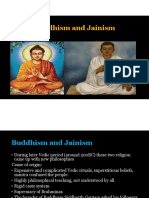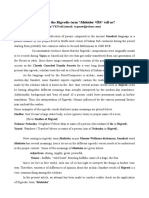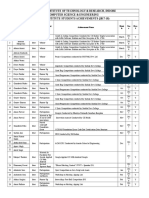100%(1)100% found this document useful (1 vote)
2K views5 pagesThe Contribution of Indian Artists in The Struggle For National Freedom Movement
Gf
Uploaded by
Anant GuptaCopyright
© © All Rights Reserved
Available Formats
Download as DOCX, PDF, TXT or read online on Scribd
Download as docx, pdf, or txt
100%(1)100% found this document useful (1 vote)
2K views5 pagesThe Contribution of Indian Artists in The Struggle For National Freedom Movement
Gf
Uploaded by
Anant GuptaCopyright
© © All Rights Reserved
Available Formats
Download as DOCX, PDF, TXT or read online on Scribd
Download as docx, pdf, or txt
Download as docx, pdf, or txt
You are on page 1/ 5
The contribution of Indian artists in the struggle for
National Freedom Movement
1. Describe the contribution of Indian artists in the
struggle for National Freedom Movement.
As the glorious tradition of Indian classical art was about to be
wiped out with the advent of Muslim rule in the middle ages, in
the same way Indian classical art of Rajasthani, Mughal, and
Pahari miniature painting was about to meet the same fate with
the establishment of British rule after the mutiny of 1857.
The systematic propaganda by scholars like Lord Macaulay, an
important member of the British Government, who drew up the
syllabus for Indian schools and framed the Indian penal code, and
the then principals of the art and craft schools of Bombay,
Madras, and Lahore, and even established painters of the status
of Burne-Jones and Jeshua Reynolds, were of the view that India
had no worthwhile traditional art and Indians were incapable of
learning it. They did their best to establish the superiority of
Western art and culture over the Indians. The newly educated
young men in those days, around 1850–1900, sneered at
anything Indian and learned to look at the pantheon of Indian
gods and goddesses as monsters.
The common Indian whose life was connected with creative
painting and flower decorations as an integral aspect of cultural
and religious celebration was completely perplexed and felt
inferior to the western educated individual. At this point, a few
extraordinarily gifted artists and painters like Abanindranath
Tagore, Gaganendranath Tagore, Nandalal Bose, Asit Kumar
Haldar, Kshitindranath Majumdar, Abdul Rehman Chugtai, and
Samarendranath Gupta, ably assisted by principal E.B. Havell of
the Calcutta Art School, came out with their excellent art to
establish once and The brilliant artist provided a huge moral boost
to the Indian nationalist movement, which started in 1905 against
the partition of Bengal.
The Indian Society of Oriental Art was founded in 1907 by
prominent Bengali artists and art collectors. Every year, the club
hosted art exhibitions and had certain works published in its
monthly journals, "Modern Review" and "Prabasi." This sparked lot
of interest in printing for publications in Japan and England.This
sparked a lot of excitement among the Indians. Nandalal Bose,
Asit Kumar Haldar, and Samarendranath Gupta accompanied
Lady Herringham of the Indian Society of London to the Ajanta,
Ellora, and Bagh caves to copy the paintings in those caves with
the assistance and involvement of sister Nivedita. The
reproductions were published in several European periodicals,
showing the antiquity andmagnificence of Indian art. It boosted
national pride throughout the country to refer to themselves as
Indians. Meanwhile, Abanindranath created a painting of 'Bharat
Mata' and the siddhas of the upper air.
BHARAT MATA BY ABANINDRANATH
Abanindranath’s Bharat Mata was the originator of the roti-kapda-
makan theme of later India. It was his answer to the rising
Swadeshi sentiment and the public uproar against the partition of
Bengal. He painted a young woman, with four arms in the manner
of Hindu deities, holding objects symbolic of India’s national
aspirations in view of the traditional idea of the nation as the
mother goddess.
It showed a Bengali peasant woman draped in saffron from head
to toe,holding in her arms a piece of white cloth, a book,a sheaf
of grain, and a rosary. They are symbolic of the need to meet the
basic economic needs of people.
Another 'bharat mata' painted by shri Purna Gosh is based on the
song 'The day when Bharat Janani rose from the blue waves of the
ocean, the entire world went down to show devotion to her and
the earth was filled with laughter'. The painting depicts a
magnificent lady who has just risen from the sea. She is dressed
in a blue saree with a red border and is holding a sheaf of ripened
paddy. She is wearing a diamond studded coronet on her head
and a pearl necklace around her neck. This was the painter's
vision of India, surrounded by blue seas and snow-capped
Himalayas like a coronet on her head.
Amrita Shergil, a modern artist who looked at India realistically
and without romance, 'Bharat Mata,' a destitute elderly lady in a
white saree, covering a naked child on her lap and holding
another girl child in a worn-out saree, was painted. All of their
faces are full of sorrow.
The caricature entitles ‘peace declared in the Punjab"—made by
Gaganendranath on the massacre of Jaliawala Bagh in 1921—
brought out the barbarous naked cruelty of the British rulers and
hatred of Indian people against the British. Nandalal’s ‘sati’, "the
death of Sati’, ‘Ahalaya’s release from her curse’, and "Agnidevta’
won acclaim throughout, which revived the traditional culture.
All these helped the people regain their national identity and gave
a boost to the national ‘Swadeshi’ movement for freedom. Indians
lost the sense of a rootless alien entity, which is the greatest
stumbling block to prosperity and self-reliance for a nation, wrote
Rabindranath Tagore. The panels on Indian folk art and Indian life
done in 1937 for Haripura Congress by Nandalal Bose gave a
great boost to this sense of Indianess among the people.
TILLER OF SOIL BY NANDLAL BOSE
NAME TILLER OF THE SOIL
ARTIST NAND LAL BOSE
MEDIUM WATER COLOUR (TEMPERA)
COURTESY : NATIONAL GALLERY OF MODERN ART, NEW DELHI
Subject matter: This is one of the panels painted by Nand Lal
Bose to decorate one of the several huts in the pandal for the
Haripura Congress Adhiveshan.
Description: Nand Lal's art was remarkable for its bold lines and
simple colour work. Each panel has a similar compositional
arrangement painted on large-sized handmade paper; a cusped
arch marks the space for rural activities. People are shown busy
with their daily chores, be it a carpenter, a smith, wrestlers,
warriors, musicians, or women husking.
In this particular panel, a farmer is shown tilling the land with a
wooden plough driven by a pair of white bullocks. The farmer is
holding a stick to drive the animals. The entire force of a farmer's
action is concentrated on managing his plough. The humped bulls
are energetic and well decorated. There are tassels around the
neck, and a cloth with a border covers their backs. Their front
hooves are raised to depict forward movement. The upturned soil
is indicated by curvilinear lines on the ground. The body of the
bull is highlighted with bold strokes of white; the dhoti and turban
of the farmer are also white. His bare torso is muscular, tanned
with his daily labour.
The earthy colours used are brown, indigo, and white against a
light ochre background, justifying the simplicity of rural life. The
curvy contours are highlighted simply with flat colours and freely
marked black outlines. A few masterly brush strokes at the
correct places have succeeded in portraying the anatomical
details of the bodies of animals as well as the farmer. The
economy of line and boldness of the strokes in these posters of
Haripura are similar to the style of the Pata-chitras of Kalighat.
You might also like
- Class 12th Chapter No - 06 The Modern Trends in Indian Art100% (7)Class 12th Chapter No - 06 The Modern Trends in Indian Art36 pages
- Objective Type Question Class - Xiith Term Test - 189% (9)Objective Type Question Class - Xiith Term Test - 167 pages
- A) Intoduction: Jharcraft: A Strong Backbone of The Jharkhand State0% (1)A) Intoduction: Jharcraft: A Strong Backbone of The Jharkhand State37 pages
- Ch.6. Q. & Ans. of Introduction To The Bengal School of Painting100% (1)Ch.6. Q. & Ans. of Introduction To The Bengal School of Painting10 pages
- Contribution of Indian Artist To National Freedom MovementNo ratings yetContribution of Indian Artist To National Freedom Movement8 pages
- Class - 12th Chapter No - 5 The Bengal School of Painting100% (2)Class - 12th Chapter No - 5 The Bengal School of Painting25 pages
- 12 Painting-Chapter-The Bengal School of Painting-Notes54% (24)12 Painting-Chapter-The Bengal School of Painting-Notes9 pages
- Class 12: Fine Arts Unit: 3 - National Flag of India & Its Symbolic Significance100% (1)Class 12: Fine Arts Unit: 3 - National Flag of India & Its Symbolic Significance2 pages
- Fine Arts Chapter 1 The Manuscript Painting TraditionNo ratings yetFine Arts Chapter 1 The Manuscript Painting Tradition3 pages
- The Rajasthani School of Miniature Painting33% (3)The Rajasthani School of Miniature Painting3 pages
- The Bengal School of Painting: Origin and Development 1No ratings yetThe Bengal School of Painting: Origin and Development 16 pages
- Class 12 Notes Fine Arts Chap 2 (2024-25)No ratings yetClass 12 Notes Fine Arts Chap 2 (2024-25)3 pages
- Class - 12th Chapter - 03 The Mughal School of Miniature Painting100% (3)Class - 12th Chapter - 03 The Mughal School of Miniature Painting11 pages
- UNIT-1 History of Indian Art The Rajasthani School of Miniature Painting Origin and DevelopmentNo ratings yetUNIT-1 History of Indian Art The Rajasthani School of Miniature Painting Origin and Development10 pages
- Full Notes Graphic Print and Modern Sculpture Class 12No ratings yetFull Notes Graphic Print and Modern Sculpture Class 128 pages
- Class - 12th Chapter - 04 Deccan School of Miniature Painting100% (4)Class - 12th Chapter - 04 Deccan School of Miniature Painting10 pages
- Introduction - Origin and Development - Sub-Schools - Mewar, Bondi, Jodhpur, Bikaner, Kishangarh, Jaipur - Pantings100% (1)Introduction - Origin and Development - Sub-Schools - Mewar, Bondi, Jodhpur, Bikaner, Kishangarh, Jaipur - Pantings12 pages
- Mughal School of Miniature Paintings: 16 Century A.D. To 19 Century A.D67% (3)Mughal School of Miniature Paintings: 16 Century A.D. To 19 Century A.D17 pages
- Ch.03. Q. The Mughal School of Miniature Paintings50% (2)Ch.03. Q. The Mughal School of Miniature Paintings2 pages
- Class Xii Fine Art's Notes Unit 1 Rajasthani School of Miniature Raingting100% (1)Class Xii Fine Art's Notes Unit 1 Rajasthani School of Miniature Raingting14 pages
- Sample Question Paper Applied Arts (SUBJECT CODE-052) CLASS XII (SESSION 2021-2022) Term - 1No ratings yetSample Question Paper Applied Arts (SUBJECT CODE-052) CLASS XII (SESSION 2021-2022) Term - 14 pages
- Class - 12th Chapter - 02 Pahari School of Miniature Painting100% (2)Class - 12th Chapter - 02 Pahari School of Miniature Painting9 pages
- Class Xii Fine Art's Notes Unit 1 Rajasthani School of Miniature Raingting100% (3)Class Xii Fine Art's Notes Unit 1 Rajasthani School of Miniature Raingting14 pages
- Class - Xii - Painting and Sculpture - Study of Pahari Painting - WS - 5 - 2020100% (1)Class - Xii - Painting and Sculpture - Study of Pahari Painting - WS - 5 - 20204 pages
- MCQ and Important Notes (Bengal and Modern School of Art)100% (1)MCQ and Important Notes (Bengal and Modern School of Art)65 pages
- Class - 12th Chapter - 01 The Rajasthani School of Miniature Painting78% (9)Class - 12th Chapter - 01 The Rajasthani School of Miniature Painting11 pages
- Class Xii Painting Evolution of Indian National Flag Ws 13 2020100% (1)Class Xii Painting Evolution of Indian National Flag Ws 13 20202 pages
- Class 12 Complete Book of Fine Art An Introduction To Indian Art 2 English PDF100% (2)Class 12 Complete Book of Fine Art An Introduction To Indian Art 2 English PDF164 pages
- The Mughal School of Miniature Painting: Origin and Development100% (10)The Mughal School of Miniature Painting: Origin and Development4 pages
- Origin, Development and Main Features of The Bengal School of PaintingNo ratings yetOrigin, Development and Main Features of The Bengal School of Painting6 pages
- Bengal school of painting and Modern trends in Indian ArtNo ratings yetBengal school of painting and Modern trends in Indian Art9 pages
- Sri Narasimha Homa: Basic Procedure (Laghu)No ratings yetSri Narasimha Homa: Basic Procedure (Laghu)6 pages
- Syllabus: FOR (Compulsory, Elective & Pass)No ratings yetSyllabus: FOR (Compulsory, Elective & Pass)61 pages
- List of Sanskrit Periodicals: Newspapers and Magazines in India & AbroadNo ratings yetList of Sanskrit Periodicals: Newspapers and Magazines in India & Abroad7 pages
- Instant download The Educational Heritage of Ancient India How an Ecosystem of Learning Was Laid to Waste 1st Edition Sahana Singh pdf all chapter100% (5)Instant download The Educational Heritage of Ancient India How an Ecosystem of Learning Was Laid to Waste 1st Edition Sahana Singh pdf all chapter55 pages
- Selected Applications For New License Saw Mill On 12/12/2018 14:33:12No ratings yetSelected Applications For New License Saw Mill On 12/12/2018 14:33:1220 pages
- Punjab, Haryana, Chandigarh and Himachal Pradesh, India: Market SummaryNo ratings yetPunjab, Haryana, Chandigarh and Himachal Pradesh, India: Market Summary2 pages
- Department of Registration, Excise & Prohibition, Govt of Bihar WebNo ratings yetDepartment of Registration, Excise & Prohibition, Govt of Bihar Web1 page
- What Does Rigvedic Term "Mahisha" Tell UsNo ratings yetWhat Does Rigvedic Term "Mahisha" Tell Us16 pages
- Lily Thomas and Ors Vs Union of India UOI and Ors 0927s000503COM506930No ratings yetLily Thomas and Ors Vs Union of India UOI and Ors 0927s000503COM50693024 pages
- INTER INTRA INSTITUTE 2017 18 PDF - Io - PDFNo ratings yetINTER INTRA INSTITUTE 2017 18 PDF - Io - PDF3 pages
- Christianity in A Different Light: Face Behind The Mask (2004)100% (2)Christianity in A Different Light: Face Behind The Mask (2004)326 pages
- Class 12th Chapter No - 06 The Modern Trends in Indian ArtClass 12th Chapter No - 06 The Modern Trends in Indian Art
- Objective Type Question Class - Xiith Term Test - 1Objective Type Question Class - Xiith Term Test - 1
- A) Intoduction: Jharcraft: A Strong Backbone of The Jharkhand StateA) Intoduction: Jharcraft: A Strong Backbone of The Jharkhand State
- Ch.6. Q. & Ans. of Introduction To The Bengal School of PaintingCh.6. Q. & Ans. of Introduction To The Bengal School of Painting
- Contribution of Indian Artist To National Freedom MovementContribution of Indian Artist To National Freedom Movement
- Class - 12th Chapter No - 5 The Bengal School of PaintingClass - 12th Chapter No - 5 The Bengal School of Painting
- 12 Painting-Chapter-The Bengal School of Painting-Notes12 Painting-Chapter-The Bengal School of Painting-Notes
- Class 12: Fine Arts Unit: 3 - National Flag of India & Its Symbolic SignificanceClass 12: Fine Arts Unit: 3 - National Flag of India & Its Symbolic Significance
- Fine Arts Chapter 1 The Manuscript Painting TraditionFine Arts Chapter 1 The Manuscript Painting Tradition
- The Bengal School of Painting: Origin and Development 1The Bengal School of Painting: Origin and Development 1
- Class - 12th Chapter - 03 The Mughal School of Miniature PaintingClass - 12th Chapter - 03 The Mughal School of Miniature Painting
- UNIT-1 History of Indian Art The Rajasthani School of Miniature Painting Origin and DevelopmentUNIT-1 History of Indian Art The Rajasthani School of Miniature Painting Origin and Development
- Full Notes Graphic Print and Modern Sculpture Class 12Full Notes Graphic Print and Modern Sculpture Class 12
- Class - 12th Chapter - 04 Deccan School of Miniature PaintingClass - 12th Chapter - 04 Deccan School of Miniature Painting
- Introduction - Origin and Development - Sub-Schools - Mewar, Bondi, Jodhpur, Bikaner, Kishangarh, Jaipur - PantingsIntroduction - Origin and Development - Sub-Schools - Mewar, Bondi, Jodhpur, Bikaner, Kishangarh, Jaipur - Pantings
- Mughal School of Miniature Paintings: 16 Century A.D. To 19 Century A.DMughal School of Miniature Paintings: 16 Century A.D. To 19 Century A.D
- Ch.03. Q. The Mughal School of Miniature PaintingsCh.03. Q. The Mughal School of Miniature Paintings
- Class Xii Fine Art's Notes Unit 1 Rajasthani School of Miniature RaingtingClass Xii Fine Art's Notes Unit 1 Rajasthani School of Miniature Raingting
- Sample Question Paper Applied Arts (SUBJECT CODE-052) CLASS XII (SESSION 2021-2022) Term - 1Sample Question Paper Applied Arts (SUBJECT CODE-052) CLASS XII (SESSION 2021-2022) Term - 1
- Class - 12th Chapter - 02 Pahari School of Miniature PaintingClass - 12th Chapter - 02 Pahari School of Miniature Painting
- Class Xii Fine Art's Notes Unit 1 Rajasthani School of Miniature RaingtingClass Xii Fine Art's Notes Unit 1 Rajasthani School of Miniature Raingting
- Class - Xii - Painting and Sculpture - Study of Pahari Painting - WS - 5 - 2020Class - Xii - Painting and Sculpture - Study of Pahari Painting - WS - 5 - 2020
- MCQ and Important Notes (Bengal and Modern School of Art)MCQ and Important Notes (Bengal and Modern School of Art)
- Class - 12th Chapter - 01 The Rajasthani School of Miniature PaintingClass - 12th Chapter - 01 The Rajasthani School of Miniature Painting
- Class Xii Painting Evolution of Indian National Flag Ws 13 2020Class Xii Painting Evolution of Indian National Flag Ws 13 2020
- Class 12 Complete Book of Fine Art An Introduction To Indian Art 2 English PDFClass 12 Complete Book of Fine Art An Introduction To Indian Art 2 English PDF
- The Mughal School of Miniature Painting: Origin and DevelopmentThe Mughal School of Miniature Painting: Origin and Development
- Origin, Development and Main Features of The Bengal School of PaintingOrigin, Development and Main Features of The Bengal School of Painting
- Bengal school of painting and Modern trends in Indian ArtBengal school of painting and Modern trends in Indian Art
- List of Sanskrit Periodicals: Newspapers and Magazines in India & AbroadList of Sanskrit Periodicals: Newspapers and Magazines in India & Abroad
- Instant download The Educational Heritage of Ancient India How an Ecosystem of Learning Was Laid to Waste 1st Edition Sahana Singh pdf all chapterInstant download The Educational Heritage of Ancient India How an Ecosystem of Learning Was Laid to Waste 1st Edition Sahana Singh pdf all chapter
- Selected Applications For New License Saw Mill On 12/12/2018 14:33:12Selected Applications For New License Saw Mill On 12/12/2018 14:33:12
- Punjab, Haryana, Chandigarh and Himachal Pradesh, India: Market SummaryPunjab, Haryana, Chandigarh and Himachal Pradesh, India: Market Summary
- Department of Registration, Excise & Prohibition, Govt of Bihar WebDepartment of Registration, Excise & Prohibition, Govt of Bihar Web
- Lily Thomas and Ors Vs Union of India UOI and Ors 0927s000503COM506930Lily Thomas and Ors Vs Union of India UOI and Ors 0927s000503COM506930
- Christianity in A Different Light: Face Behind The Mask (2004)Christianity in A Different Light: Face Behind The Mask (2004)




















